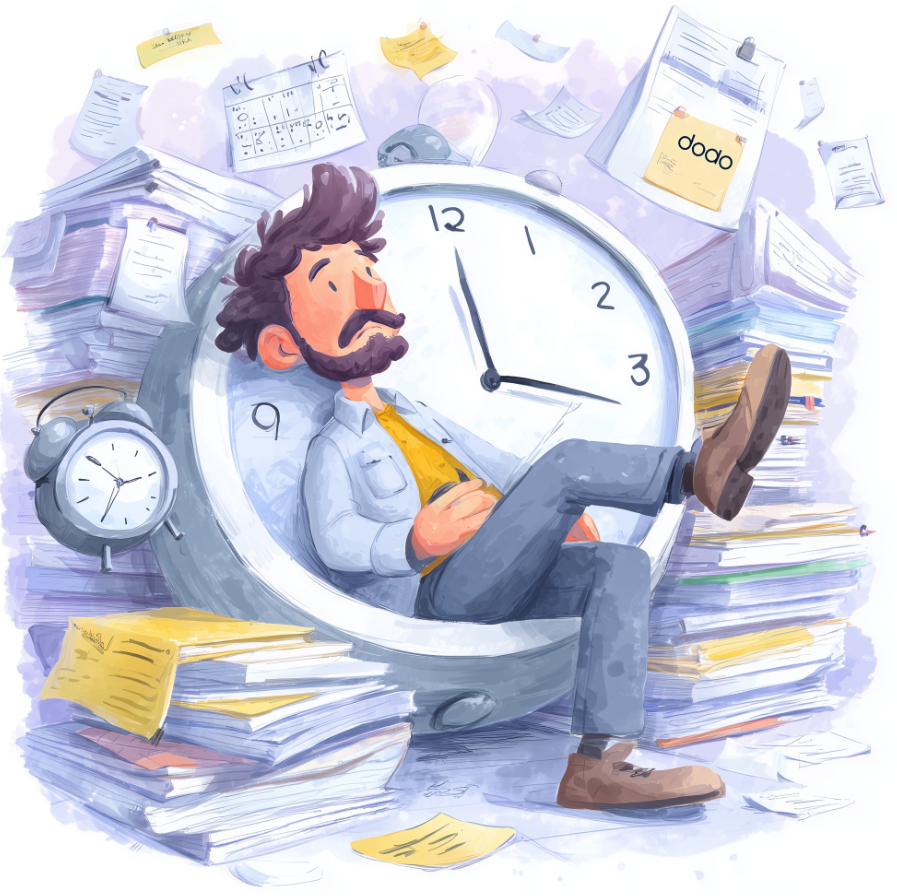
Oct. 15th, 2025


Written by Dan Mintz, a leading productivity strategist, expert in the 12 week year, and the founder of the 12-Week Breakthrough Program. Wharton MBA, MIT Data Scientist, 3x Entrepreneur.
Worked with dozens of people to transform their lives in 12 weeks.
If you’ve ever sat in front of your laptop promising yourself, “I’ll start in five minutes”—and somehow ended up deep in your inbox or scrolling through social media—you’re not lazy. You’re human. The modern world simply wasn’t designed for focus.
And here’s the truth most people miss: procrastination isn’t about time—it’s about attention. You don’t need more motivation; you need less noise and a better system for execution.
That’s where two frameworks come together powerfully: Digital Minimalism by Cal Newport and The 12 Week Year by Brian Moran and Michael Lennington. One clears your digital clutter; the other gives your focus direction. When you combine them, you not only stop procrastinating—you start producing at a level that surprises you.
I know, because I’ve lived it.
For years, I was caught in what I now call the “illusion of progress.” My days were filled with learning, researching, and organizing—but not doing. My clients felt the same. They had ambitious visions, endless tabs open, and zero momentum. The shift happened when I condensed their time horizons to 12 weeks and stripped their digital life to its essentials. The results were astonishing—projects completed, launches shipped, energy restored.
This is the blueprint we’ll explore: how to beat procrastination using the 12 Week Year and Digital Minimalism together.
Let’s start by getting brutally honest: procrastination is rarely about laziness. It’s an emotional avoidance mechanism.
When you delay action, it’s not because you lack discipline—it’s because you’re trying to avoid the discomfort of uncertainty, imperfection, or effort. Add to that the avalanche of digital noise—emails, messages, notifications—and you’ve got a perfect storm for distraction.
In his book Digital Minimalism, Cal Newport explains that modern technology hijacks our dopamine system. Every like, ping, or “quick check” on Slack rewards you with microbursts of stimulation. The brain starts craving these quick hits, pushing meaningful but uncomfortable work (writing, creating, leading) further down the list.
Procrastination, then, isn’t a moral failure—it’s a mismatch between what our brains evolved for (focused, linear effort) and the environment we live in (fragmented, attention-hacking chaos).
A client of mine—a designer—once told me, “I open Figma and somehow end up in Reddit threads about productivity.” That’s the modern trap: infinite preparation, zero execution.
The way out isn’t to force yourself to “try harder.” It’s to redesign your environment and compress your timeline so that execution becomes inevitable.
Most productivity systems fail because they stretch your goals over 12 months. A year feels safe, generous, comfortable—and that’s exactly the problem.
Twelve months gives you too much room to delay. “I’ll start next week” feels rational when you have 50 weeks left. You can drift for months and still feel like you’re “planning.”
That’s what I did for years. Every January, I’d buy a new planner, color-code my vision, and by February, the fire was gone. My clients repeated the pattern—big goals, vague execution.
The breakthrough came when I stopped thinking in years and started thinking in 12-week cycles. Suddenly, everything changed: urgency rose, procrastination shrank, and action became non-negotiable.

The 12 Week Year, developed by Brian Moran and Michael Lennington, flips the traditional model. Instead of planning for 12 months, you treat 12 weeks as a full year—with its own goals, strategy, execution, and review.
Here’s the structure:
The power of this approach is psychological: 12 weeks is short enough to feel urgent but long enough to create real results. You can’t hide behind “someday.” Every week counts.
When I implemented this system with a client—a freelance marketer overwhelmed by too many ideas—her entire rhythm shifted. Instead of 12 scattered goals, she focused on one: building her first evergreen funnel. We broke it into weekly MITs and set a single WAM every Friday. Within 11 weeks, the funnel was live and producing revenue.
Procrastination vanished—not because she changed as a person, but because the system made drift impossible.
The 12 Week Year gives you focus. But to protect that focus, you need to reclaim your attention from the digital noise.
That’s where Digital Minimalism comes in. Cal Newport’s framework isn’t about deleting all your apps or going off the grid. It’s about using technology intentionally—choosing depth over distraction.
Digital Minimalism rests on three principles:
I applied this to my own workflow by doing a 30-day Digital Declutter. I removed every app that wasn’t directly connected to my 12-week goals. The result? My screen time dropped by 40%, but my productivity doubled.
One of my clients, a software developer, adopted this system by limiting phone use to three blocks per day and checking email only twice daily. He reported something fascinating: “I thought I was addicted to my phone, but I was actually addicted to avoiding discomfort.”
Digital Minimalism doesn’t just help you focus—it removes the excuses you use to avoid hard work.
When you blend Digital Minimalism with the 12 Week Year, procrastination loses its two biggest allies: distraction and delay.
Here’s how the integration works in practice:
When I applied this synergy with a coaching client—a creative entrepreneur drowning in digital chaos—she cut her input sources by half and followed a 12-week publishing sprint. By week 10, she had launched a full content library she’d been “planning” for over a year.
The key insight? You can’t execute deeply if your attention is fractured. Minimalism clears the runway. The 12 Week Year gives the flight path.
Here’s your roadmap to start today:
When you align your attention (Digital Minimalism) with your execution system (12 Week Year), procrastination simply has nowhere to hide.
Even powerful systems fail when misused. Here are the traps to watch for:
I learned this the hard way. During my second 12-week cycle, I started reintroducing “productive distractions”—checking analytics, tweaking systems. My output dropped by half. Once I removed the noise again, momentum returned instantly.
When you look beneath the surface, both systems share a common foundation: clarity, intentionality, and feedback.
Together, they reshape not just your workflow but your identity. You stop thinking like a procrastinator and start acting like a producer.

Dan Mintz is the creator of the 12 Week Breakthrough Program. He advised dozens of individuals on how to achieve their most ambitious goals and reach their full potential.
Dan can be reached at:
dan.mintz@12week-breakthrough.com
About Dan Mintz
Additional Links:
Join the Program
Our Blog Page
Amazing Productivity Blogger
Social Links:
LinkedIn
X / Twitter
Instagram
It compresses your time horizon. When you only have 12 weeks, you can’t delay. You act faster, reflect sooner, and learn quicker. Each cycle becomes a sprint instead of a marathon.
By removing digital clutter. Every notification you silence and app you delete is one less opportunity for distraction. Your attention becomes directed rather than scattered.
Absolutely. Most of my clients are professionals or entrepreneurs. You can apply Digital Minimalism during work hours (batching communication, using deep work blocks) and run your 12-week execution cycle in parallel.
Don’t start over—adjust. Run a short WAM (Weekly Accountability Meeting), analyze where you drifted, and resume. The point isn’t perfection; it’s iteration.
GTD helps you capture tasks; OKRs help set metrics. The 12 Week Year gives you execution urgency, while Digital Minimalism ensures your attention is available to execute. It’s focus + action.
Usually within two weeks. Once distractions drop and you operate in weekly cycles, you’ll notice immediate clarity and progress.
Start small. One goal, three weekly MITs, one WAM. You don’t need to change everything—just the rhythm of your week.
Yes. Most creators procrastinate because they’re overstimulated. Limiting input (Digital Minimalism) and setting short output cycles (12WY) builds consistent creative flow.
No problem. The goal isn’t zero tech—it’s intentional tech. Use only what serves your 12-week priorities. Mute the rest.
Each 12-week cycle builds momentum. Four cycles a year equals compound progress. You still pursue long-term visions—but now you have structure and measurable wins every quarter.
They help, but not required. Many of my clients hold solo WAMs with written reviews. The key is honesty—measure, reflect, adjust.
Stop treating procrastination as a problem of willpower. It’s a system problem. Redesign your attention (Digital Minimalism) and time horizon (12WY), and execution will follow.
Procrastination thrives in open-ended timelines and distracted environments. The antidote is simple but powerful: shrink your year and simplify your world.
Digital Minimalism clears the noise. The 12 Week Year channels the focus. Together, they form a structure where action becomes natural, not forced.
Twelve weeks from today, you can look back at a finished goal—or another season of excuses. The difference lies in what you do next.
Start your 12-week year. Declutter your digital life. And make progress the default setting of your life.